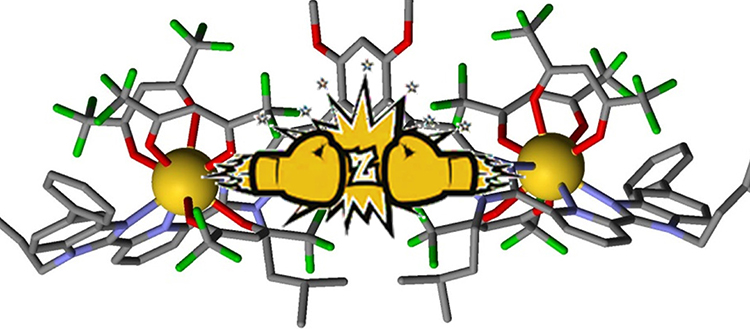Making molecules asocial to boost their energy
Chemists at UNIGE have succeeded in organising molecules at will by forcing them to repudiate their peers. The ultimate goal? To convert infrared light into visible light.

In order to create a molecular chain of rare earths, it is necessary to give the molecule an “asocial character”, as illustrated above. © UNIGE
Light that is visible to the human eye is situated between ultraviolet (high energy) and infrared (low energy). This is the window in which solar cells capture light to produce energy. However, nearly 50% of solar radiation is found in the low-energy zone that is near and far infrared. Chemists from the University of Geneva (UNIGE), Switzerland, are in the process of making infrared light “visible” by piling up its constituent photons to increase its energy through a molecular chain made up of an alternation of rare earth elements. For this process to work, the similar elements, which tend to regroup at the same place, must reject each other violently so that they are not neighbours in the chain. To achieve this unique feat, the UNIGE researchers programmed and modified the rare earth molecules, inducing them to repel their fellow molecules. You can find out all about the work in the journal Chemical Science.
Fifteen elements in the periodic table are known as rare earths: not because they are difficult to find across the world but because they have specific chemical, magnetic and optical characteristics. This explains why, with the rise of electronics, rare earths are used in the vast majority of everyday objects, including magnets, lights, batteries and catalysts.
The UNIGE chemists, working in tandem with the CNRS Centre for Molecular Biophysics in Orléans, wanted to know whether it would be possible to combine different rare earth molecules to encourage the photons in the infrared zone to move towards the visible light and make them usable by our solar cells.
Boost energy: reject your neighbour
To create a molecular chain of rare earths (known as a polymeric chain), two rare earths – ytterbium and erbium – need to be selected and alternated in the small molecular receptors that constitute the chain so that energy could be transferred. However, ytterbium and erbium molecules tend to cluster in the same places in the chain, preventing alternation. “We had to find a solution so that, when a rare earth molecule fills a receptor, it rejects similar molecules from neighbouring receptors,” explains Claude Piguet, a professor in the Department of Inorganic and Analytic Chemistry in UNIGE’s Faculty of Science.
The UNIGE chemists decided to manipulate the rare earth molecules directly using groups of atoms that destabilise the symmetry of the elements. Professor Piguet points out: “We destroyed the centre of symmetry of the molecule, which altered its properties and created its asocial character that drives it to reject any rare earth molecule that wants to settle in the neighbouring receptor.”
A history of cooperativity
But how does the molecule know whether the neighbouring receptor is empty or full? As soon as one of the receptors receives a rare earth molecule, it warns its neighbouring receptors using the principle of cooperativity, which binds the behaviour of the molecule’s receptors. In fact, when the receptor is full, it changes its affinities with its neighbours, and attracts or repels the molecules that would like to settle there. “This principle is essential for allowing us to make the molecules asocial,” explains Piguet. “For the moment, we can’t alternate a ytterbium and erbium molecule, but we can ensure that when a ytterbium takes its place, no other rare earth can come and settle to its left or right. This is thanks to the rule of cooperativity, which makes it reject all possible neighbours.”
The UNIGE scientists are at the first stage of the polymer chain organisation, which should ultimately make infrared energy visible once the gaps are filled by erbium molecules. The final word is left to Claude Piguet: “Fifteen years ago, it seemed impossible that we would be able to manipulate and pile up photons using rare earth molecules. But now we can arrange and sort them how we want. It’s a huge step towards using infrared light in new tools that we could then reproduce at will and employ in our day-to-day lives.”
